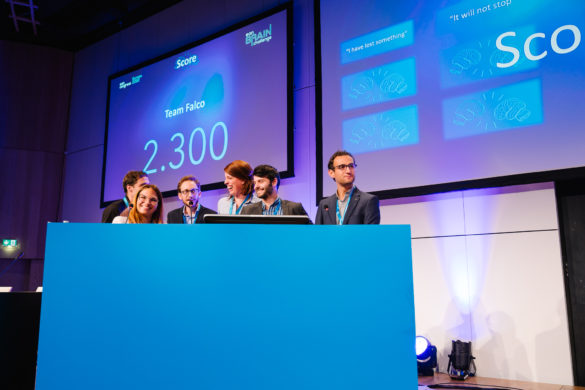By Juliette Dufour
During the Special Session Clinical Grand Rounds ‘The long and winding road to the diagnosis’ three experts (Patrick Altmann, Gregor Kasprian and Romana Höftberger) discussed the clinical, neuropathological and radiological findings of three atypical cases treated at the Department of Neurology in Vienna.
First, they described the case of a 39-year-old pregnant women who was transferred to hospital for pre-eclampsia and who presented dizziness and cephalalgia. The first MRI examinations were strictly normal. That allowed Dr. Kasprian to talk about differential diagnosis in this context: (i) PRES (Posterior Reversible Encephalopathy) syndrome that is characterised with posterior vasogenic oedema and not cytotoxic. The difference between vasogenic and cytotoxic oedema is made on ADC maps, indeed in both cases we can observe a hypert2 and hyperDWI signal but in the cytotoxic oedema ADC will be restricted and not in case of vasogenic oedema; (ii) Another differential diagnosis is the Central Pontine Myelinosis, characterised by a cytotoxic oedema in the pons.
Back to the clinical point of view, the patient then developed severe neurologic symptoms four days later, with right hemiplegia and sensory loss. A new MRI was performed and showed a hypersignal in FLAIR, hyperDWI and restricted ADC in the pons. These results allow Dr. Kasprian to discuss another differential diagnosis: Diffuse Intrinsic Pontine Glioma, which is characterised by hypert2 signal with mass effect, a contrast uptake and a choline peak in MR-spectroscopy.
From the point of view of a neuropathologist, what should you think about when faced with a brainstem injury? Dr. Höftberger provided an overview of autoimmune brainstem encephalitis. This can be divided into four main groups: (i) opsoclonus-myoclonus (paediatric patients: neuroblastoma; young adults: idiopathic or post infectious; adults: paraneoplastic) (ii) Bickerstaff brainstem encephalitis (Miller Fisher syndrome, GBS with ophthalmoplegia associated with anti-GQ1b antibodies); (iii) Paraneoplastic with intra-cellular antibodies, (iv) Anti-neuronal surface autoimmunity (IGLON5, anti-GABAR).
All these exams were tested negative in our patient. The lab results were also negative, including vasculitis screening and lupus antibodies. A few days later the patient developed dysphagia and consciousness. An injected CT-Scan was performed and found no contrast in the right vertebral artery. The clinicians came to the conclusion of an acute stroke in the territory of the right vertebral artery. To help the decision between thrombus and dissection, a special MRI sequence was done, known as the ‘black blood sequence’ (= attenuation of the blood flow signal) to allow the radiologist to distinguish an intramural haematoma from an intraluminal thrombus.
Back to the clinic, our patient recovered, and symptoms were entirely resolved in one month.
In conclusion, the complete diagnosis adopted was a HELLP syndrome with spontaneous dissection of right artery. It should be noted that in the posterior fossa, hypert2 FLAIR due to acute stroke can regress with no sequelae. The experts recommend to read Adlow et al, Lancet Neurol 2013, which made a complete overview of complications of pregnancy and neurology.
The second case was about a 53-year-old woman who presented for dizziness with a past medical history of breast cancer. The clinical examination showed a right nystagmus, confirmed by the EOG, which was consistent with a central vestibular dysfunction. Brain MRI with ASL (perfusion without contrast agent) was normal, whole-body PET-CT as well, and laboratory exams were also negative especially for paraneoplastic antibodies.
From the radiology point of view, Dr. Kasprian exposed some differential diagnoses: (i) infectious abscess (hypert2, hyperDWI, contrast enhancement), (ii) Hypertrophic Olivary Degeneration (HOD) which is characterised by a hypert2 signal in the inferior olivary nuclear, an affect due to an injury in the Mollaret Triangle (nucleus ruber, nucleus dentatus and inferior olive nucleus); (iii) Anti Glycine Receptor antibody cerebellatis (extremely rare, patchy FLAIR in the pons and cerebellum with no contrast enhancement).
Dr. Höftberger then exposed the neuropathology point of view of the CSF analysis. First a CSF cytology was performed, and no tumour cells were found; then antibody screening was done. Indeed, there are a lot of antibodies associated with cerebellar ataxia, most of them are intracellular (Hu, Yo, Ri). How to expose these antibodies? Mainly with tissue-based assay (cerebellum incubated with serum/LCS) and then immunoblot. It is recommended to always perform two independent test methods to confirm the diagnosis. Dr. Höftberger noted that the pathomechanism is completely different in cases of intracellular antibodies (toxic T cell reaction) and surface-Ag mediated (deposition of immunoglobulin).
Finally, no confirmation of paraneoplastic cerebellar syndrome was obtained in our patient, even the exploratory laparotomy was negative, but she was treated with immunoglobulin and clinically improved.
In conclusion, diagnosis of paraneoplastic syndromes can be challenging, and antibodies can sometimes be negatives.
In the final topic, the experts discussed two cases. First a 67-year-old man who presented to UR for altered mental state without neurologic focal sign. The MRI showed cortical micro-infarcts positive in DWI and FLAIR. The next day the patient completely recovered (normal MoCA) and blood tests for ADAMTS13 and vasculitis screening were negative.
The other report was about a 23-year-old-man who presented to the UR also for altered mental state, but with a history of developmental disability and a notion of treatment for schizophrenia. A past MRI was described ‘normal’, but the new MRI at the neurology department showed a slight hyperintensity in the limbic area. Punction lumbar found 267 cells with oligoclonal immunoglobulins, and the neuropathology confirmed the diagnosis of NMDA receptor encephalitis (positive NMDA antibodies on tissue and immunoblot).
In conclusion, psychosis alone can be the first symptom of NMDA encephalitis and it can be challenging for clinicians.
The experts finished the session with a recent published case report of a neurosyphilis case mimicking auto immune encephalitis (Front Neurol 2022).










